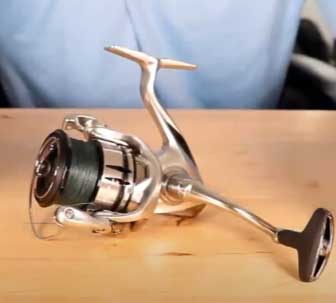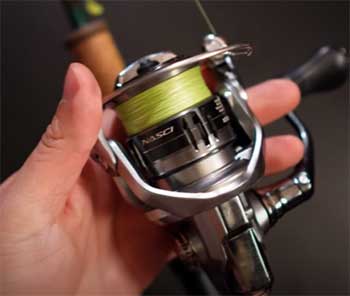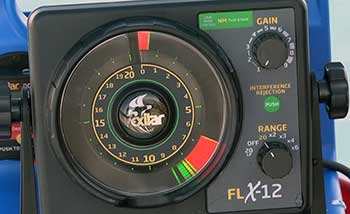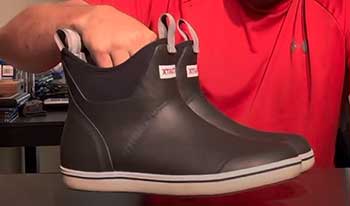I’ve spent countless hours on the water, casting lines and battling fish, and I know the right spinning reel can make or break your day. The Shimano Nasci and Stradic are two reels that consistently catch anglers’ attention, but which one’s worth your hard-earned cash?
In this article, I’ll break down their features, weigh their pros and cons, and share my firsthand insights to help you decide. Whether you’re chasing bass in freshwater or reds in the saltwater, let’s find the reel that’ll keep you hooked.
A Brief Comparison Table
| Feature | Shimano Nasci FC | Shimano Stradic FL/FM |
| Price Range | $100–$150 | $200–$250 |
| Body Material | XT-7 Composite | Aluminum (HAGANE Body) |
| Weight (2500 size) | 8.5 oz | 7.9 oz |
| Max Drag (2500 size) | 20 lbs | 20 lbs |
| Bearings | 5+1 | 6+1 |
| Gear Ratio (2500 size) | 5.0:1 (HG: 6.2:1) | 6.0:1 (HG: 6.2:1) |
| Line Retrieve (2500 size) | 29–36 inches | 34–37 inches |
| Water Resistance | CoreProtect | X-Protect, CoreProtect |
| Anti-Reverse Switch | None | None |
| Best For | Freshwater, light saltwater | Freshwater, saltwater |
My Journey With Shimano Reels
I’ve been fishing since I was a kid, and Shimano has always been a name I trusted. My first spinning reel was a beat-up Shimano Symetre, and it taught me the value of a reliable reel.
Over the years, I’ve upgraded my gear, and both the Nasci and Stradic have found spots in my tackle box. The Nasci FC has been my go-to for budget-friendly freshwater trips, while the Stradic FL has tackled tougher saltwater challenges.
Each reel has its strengths, and I’ve put them through their paces to see how they stack up.
Shimano Nasci: The Budget Workhorse
The Shimano Nasci FC is like that dependable friend who’s always ready for an adventure but doesn’t demand much. Priced around $100–$150, it’s a steal for what it offers.
I first picked up a Nasci 2500 for a weekend bass fishing trip, and it surprised me with its performance.
Key Features of The Nasci

The Nasci packs some serious tech for its price.
Its Hagane Gear, a cold-forged aluminum drive gear, is 165% more durable than zinc casting gears, giving it a robust feel.
The X-Ship technology supports the pinion gear with bearings, making cranking smooth and efficient.
I noticed this when I was reeling in a feisty smallmouth—it felt effortless.
CoreProtect adds water resistance, which is a godsend for kayak fishing where my reel often gets splashed.
The G-Free Body design shifts the center of gravity closer to the rod, reducing fatigue during long casting sessions.
I’ve spent eight-hour days on the water with the Nasci, and my wrist didn’t complain.
The Nasci comes in sizes from 500 to 5000, with gear ratios ranging from 5.0:1 to 6.2:1 (high-gear HG models). The 2500 size, my favorite, retrieves 29–36 inches of line per crank, depending on the model.
Its max drag of 20 pounds is impressive for a reel this affordable, and the Cross Carbon Drag in the 5000 size handles heavier loads.
Pros of The Shimano Nasci
- Affordability: At $100–$150, it’s a fantastic value for beginners or anglers on a budget.
- Versatility: Suitable for freshwater and light to medium saltwater fishing, from trout to redfish.
- Smooth Drag: The drag is buttery smooth, handling quick runs from reds without that jerky feel.
- Durability: Hagane Gear and CoreProtect make it tough enough for regular use.
- Lightweight: At 8.5 oz for the 2500 size, it’s easy to handle for long sessions.
Cons of The Shimano Nasci
- No Anti-Reverse Switch: This can be a hassle in situations where you need to backwind, like when playing a fish straight off the clutch.
- Fewer Bearings: With 5+1 bearings, it’s slightly less smooth than higher-end reels.
- Handle Design: The handle could be beefier, and the knob feels small for prolonged fights with bigger fish.
- Line Spooling Issues: Some users, including me, have noticed uneven line lay after heavy use, though shims can fix this.
I once had an issue where the line spooled toward the front of the Nasci’s spool after a few months. A quick shim adjustment, borrowed from another reel, solved it, but it’s something to watch for.
Shimano Stradic: The Premium Performer
The Shimano Stradic FL (and newer FM) is the Nasci’s big brother, commanding a $200–$250 price tag. I got my Stradic FL 3000 for a saltwater trip targeting snook, and it’s been a game-changer. It feels like a luxury reel without the Stella’s eye-watering cost.
Key Features of The Stradic

The Stradic boasts a HAGANE aluminum body, which is stiffer and more durable than the Nasci’s XT-7 composite.
This rigidity shines when you’re horsing fish out of cover.
The X-Ship and Hagane Gear are here too, but the Stradic adds a worm gear oscillation system for precise line lay, reducing friction and boosting casting distance.
X-Protect and CoreProtect make the Stradic more water-resistant, ideal for saltwater. I’ve dunked mine in the surf, and it’s held up without corrosion.
The Long Stroke Spool design enhances casting by minimizing line friction, and I’ve noticed my lures fly farther with the Stradic.
With 6+1 bearings, the Stradic is smoother than the Nasci. Its gear ratios range from 6.0:1 to 6.4:1, retrieving 34–37 inches per crank in the 2500 size. The max drag matches the Nasci at 20 pounds, but the Stradic’s Cross Carbon Drag feels more refined, especially under pressure.
Pros of The Shimano Stradic
- Superior Smoothness: The extra bearing and worm gear oscillation make reeling silky.
- Saltwater Ready: X-Protect and a sealed design handle harsh saltwater conditions.
- Lightweight: At 7.9 oz for the 2500 size, it’s lighter than the Nasci, reducing fatigue.
- Casting Distance: The Long Stroke Spool and Aero Wrap II improve casting accuracy and distance.
- Durability: The aluminum body and sealed internals are built for the long haul.
Cons of The Shimano Stradic
- Price: At $200–$250, it’s a significant investment compared to the Nasci.
- No Anti-Reverse Switch: Like the Nasci, it lacks this feature, which some anglers miss.
- Line Roller Maintenance: The line roller bearing can attract debris, requiring occasional cleaning.
- Not for Finesse Fishing: It’s overkill for ultra-light setups where a Vanford might shine.
I’ve had to clean the Stradic’s line roller after a few salty trips, but it’s a small price to pay for its performance. The reel’s weight and balance make it a joy to use, especially paired with a high-end rod.
Head-to-Head Comparison of Shimano Nasci And Stradic Spinning Reel

Let’s put these reels side by side and see how they fare in real-world scenarios.
- Build Quality and Materials
The Nasci’s XT-7 composite body is lightweight and corrosion-resistant, but it flexes slightly under heavy loads. The Stradic’s aluminum HAGANE body is rock-solid, with no flex even when I’m cranking against a stubborn redfish.
For freshwater or light saltwater, the Nasci’s build is plenty tough, but the Stradic’s premium construction wins for durability in harsh conditions.
- Smoothness and Performance
The Stradic’s 6+1 bearings and worm gear oscillation give it an edge in smoothness. Reeling in a fish feels like gliding on ice. The Nasci’s 5+1 bearings are no slouch, but you can feel a slight difference during prolonged retrieves.
For casual anglers, the Nasci’s smoothness is more than adequate, but the Stradic’s refinement is noticeable in demanding situations.
- Drag System
Both reels sport a 20-pound max drag in the 2500 size, but the Stradic’s Cross Carbon Drag feels more precise. I’ve fought 10-pound snappers with the Stradic, and the drag handled their surges flawlessly.
The Nasci’s drag is smooth too, but it can feel less responsive under extreme pressure. For most inshore species, either reel’s drag is up to the task.
- Water Resistance
The Nasci’s CoreProtect offers decent water resistance for splashes and light saltwater use. I’ve used it in brackish water without issues.
The Stradic’s X-Protect and CoreProtect combo is a step up, making it my choice for surf fishing or heavy saltwater exposure. If you’re fishing in corrosive environments, the Stradic’s sealing is worth the extra cost.
- Weight and Ergonomics
At 8.5 oz, the Nasci is lightweight, but the Stradic’s 7.9 oz feels even better over long sessions. The Stradic’s G-Free Body and T-Handle design make it more ergonomic, especially when paired with a high-end rod.
The Nasci’s handle knob is smaller, which can feel less comfortable during big fights. For all-day casting, the Stradic has a slight edge.
- Price and Value
The Nasci is a budget champion, delivering high-end features for $100–$150. It’s perfect for beginners or anglers who don’t need top-tier performance. The Stradic, at $200–$250, offers premium features that justify the price for serious anglers.
If you’re fishing occasionally, the Nasci’s value is hard to beat. For frequent or saltwater use, the Stradic’s longevity makes it a better investment.
Real-World Testing: My Experiences

Last summer, I took both reels to Ding Darling National Wildlife Refuge in Florida.
The Nasci 3000 was paired with a G Loomis E6X rod, targeting redfish in mangrove lagoons.
It handled 15-pound braid and a 3-inch jerkbait with ease, landing a 5-pound red after a spirited fight.
The drag was smooth, but I noticed slight line twist after a few hours.
The Stradic FL 3000, paired with a Century Weapon Jr rod, tackled snook in the same waters.
With 20-pound braid and a 4-inch paddle tail, it cast farther and felt smoother during retrieves.
I hooked a 7-pound snook, and the Stradic’s drag and body rigidity made quick work of it, even near oyster beds. The Stradic’s casting distance and smoothness were standout features.
In freshwater, I used the Nasci 2500 for bass on a local lake. It handled finesse presentations like small twitch baits well, though the lack of an anti-reverse switch was annoying when backwinding.
The Stradic 2500, used for spotted bass, felt overqualified but delivered unmatched smoothness. For finesse fishing, the Nasci is sufficient, but the Stradic’s refinement shines with bigger fish.
Who Should Choose The Nasci?
The Nasci is ideal for:
- Beginners or budget-conscious anglers.
- Freshwater fishing for bass, trout, or panfish.
- Light to medium saltwater applications, like inshore reds or snook.
- Anglers who want reliable performance without breaking the bank.
If you’re new to fishing or don’t need the absolute best, the Nasci’s balance of price and performance is tough to beat. It’s a workhorse that’ll last years with proper care.
Who Should Choose The Stradic?
The Stradic is perfect for:
- Serious anglers fishing in saltwater or harsh conditions.
- Those targeting larger species like snook, redfish, or small tarpon.
- Anglers who value smoothness, casting distance, and durability.
- Anyone willing to invest in a reel that’ll last a decade.
If you fish frequently or in challenging environments, the Stradic’s premium features justify the cost. It’s a reel you’ll pass down to your kids.
Maintenance Tips For Both Reels
Both reels benefit from regular maintenance. After saltwater trips, I rinse them with fresh water and let them air dry. For the Nasci, check the line lay periodically and adjust shims if needed.
The Stradic’s line roller bearing needs occasional cleaning to prevent debris buildup. A drop of reel oil on the bearings every few months keeps both reels spinning smoothly.
Shimano’s CoreProtect and X-Protect reduce maintenance needs, but don’t skip these steps to extend their lifespan.
Frequently Asked Questions (FAQ)
Yes, the Nasci is an excellent reel for its $100–$150 price, offering smooth performance, durability, and versatility for freshwater and light saltwater fishing.
No, the Nasci uses CoreProtect for water resistance but isn’t fully sealed. It’s suitable for light saltwater but not as robust as the Stradic’s X-Protect.
The Stradic FL was succeeded by the Stradic FM in some markets, with minor updates. The Vanford also replaced the Stradic CI4+ for lighter applications.
Yes, the Nasci is rated for light to medium saltwater use, handling inshore species like redfish, but it’s not ideal for heavy saltwater exposure.
Conclusion: Which Reel Wins?
You can’t go wrong with either the Shimano Nasci or Stradic, but your choice depends on your needs. If you’re looking for an affordable, reliable reel for freshwater or occasional saltwater trips, the Nasci’s value is unmatched.
Its smooth drag and durable build make it a fantastic starter or backup reel. But if you’re a serious angler tackling tough fish in harsh conditions, the Stradic’s smoothness, casting distance, and saltwater-ready design are worth the extra bucks.
Whichever you pick, you’re getting Shimano’s legendary quality. So, grab your rod, hit the water, and let these reels help you land the big one.

